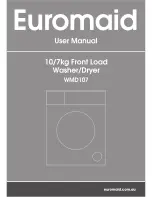
B
Ba
as
siic
c IIn
nffo
orrm
ma
attiio
on
n
1-12
To allow the cavities to empty, the cover of the
detergent drawer cover has tubes molded into it
that fit over the tubes in the cavities.
These tubes are larger than the tubes in the cavity
and are designed to fit over the tubes, but not
touch the bottom of the cavity when the cover is
installed. When water is added to either the bleach
or fabric softener liquid, the mixture level rises
between the tubes above the tubes in the cavity
and flows into the washer tub. Since the end of the
tube on the insert does not touch the bottom of
the cavity, a siphoning action will occur when the
solenoid activates and allows water into the cavity.
The added water creates an “overfill” condition
and starts the siphoning. The cavity will empty
itself when the water is turned off by the solenoid.
The bleach dispenser channel receives water from
the middle input, as viewed from the front of the
washer. The bleach channel forms a path that
allows the water to pass over the bleach cavity
section of the cavity.
As the water passes over the bleach section, holes
in the cavity allow some of the water to enter and
mix with the bleach. This raises the mixture level
above the tubes in the drawer bleach cavity
allowing the mixture to flow into the tub.
Like the detergent channel, the flow of the
incoming water is more than the holes can
dispense, allowing the excess water to back up
into the channel across the rear of the dispenser
and flow into the tub. For water to enter the fabric
softener channel, both the middle and right inlets
must be activated. As water from the left inlet
passes over the channel, it collides with the water
from the right inlet. This collision changes the
water path directing it to the front of the cavity and
into the fabric softener channel. The fabric softener
channel forms a loop that allows the water to pass
over the fabric softener cavity section of the
drawer.
As the water passes over the fabric softener
section, holes in the cavity allow some of the water
to enter and mix with the fabric softener.
This raises the mixture level above the tubes in the
drawer fabric softener cavity allowing the mixture
to flow into the tub. Like the detergent channel, the
flow of the incoming water is more than the holes
can dispense allowing the the excess water to
backup into the channel across the rear of the
dispenser and flow into the tub.
B
Blle
ea
ac
ch
h a
an
nd
d F
Fa
ab
brriic
c S
So
offtte
en
ne
err F
Fllo
ow
w T
Tu
ub
be
es
s
An available option is for a liquid detergent cup
that is placed within the main wash compartment.
This allows for the liquid detergent to be
dispensed at the proper time, and allows the liquid
detergent to be poured and held during a delay
start or held during the pre-wash.
The drawer front has a button that when pushed,
releases a latch that secures the drawer in the unit.
When the latch is released, a spring in the
dispenser housing assembly pushes the drawer
partially open. The drawer can then be pulled
open to pour additives into the drawer. The
drawer is then pushed back into place and the
latch on the drawer front assembly latches to the
console to keep the dispenser closed.
Cover Tube
Cavity Tube
Summary of Contents for EWFLW65H - 27'' Front-Load Washer
Page 2: ......
Page 16: ...B Ba as si ic c I In nf fo or rm ma at ti io on n 1 14 Notes ...
Page 17: ...Installation Information 2 1 Section 2 Installation Information ...
Page 23: ...Installation Information 2 7 Installed Washer Dimensions ...
Page 39: ...Electronic Control 3 1 Section 3 Electronic Control ...
Page 41: ...Electronic Control 3 3 Wave Touch Washer Cycle Chart ...
Page 43: ...Electronic Control 3 5 IQ Touch Washer Cycle Chart ...
Page 63: ...4 1 Component Teardown Section 4 Component Teardown ...
Page 85: ...Troubleshooting 5 1 Section 5 Troubleshooting ...
Page 91: ...6 1 Wiring Diagrams Section 6 Wiring Diagrams ...















































